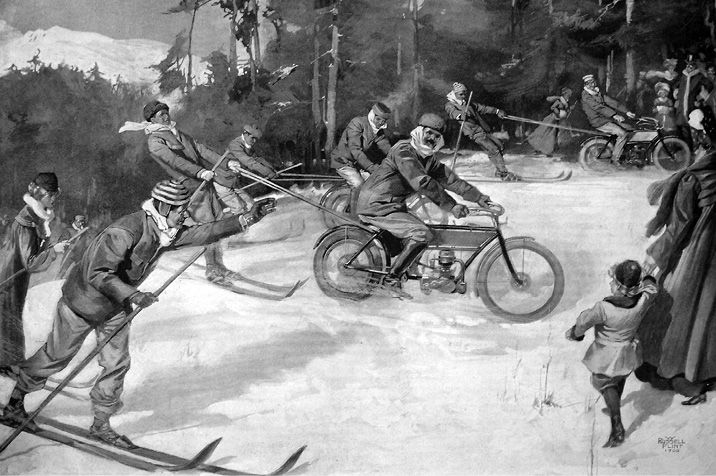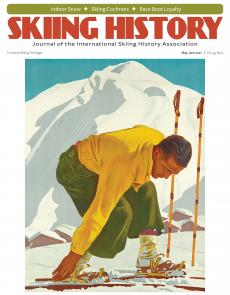SKIING HISTORY
Editor Greg Ditrinco
Consulting Editor Seth Masia
Art Director Edna Baker
Editorial Board
Seth Masia, Chairman
John Allen, Andy Bigford, John Caldwell, Jeremy Davis, Kirby Gilbert, Paul Hooge, Jeff Leich, Bob Soden, Ingrid Wicken
Founding Editors
Morten Lund, Glenn Parkinson
To preserve skiing history and to increase awareness of the sport’s heritage
ISHA Founder
Mason Beekley, 1927–2001
ISHA Board of Directors
Rick Moulton, Chairman
Seth Masia, President
Wini Jones, Vice President
Jeff Blumenfeld, Vice President
John McMurtry, Vice President
Bob Soden (Canad), Treasurer
Einar Sunde, Secretary
Richard Allen, Skip Beitzel, Michael Calderone, Art Currier, Dick Cutler, David Ingemie, Joe Jay Jalbert, Henri Rivers, Charles Sanders, Christof Thöny (Austria), Ivan Wagner (Switzerland)
Presidential Circle
Christin Cooper, Billy Kidd, Jean-Claude Killy, Bode Miller, Doug Pfeiffer, Penny Pitou, Nancy Greene Raine
Membership Services
Laurie Glover
(802) 375-1105
laurie@skiinghistory.org
Corporate Sponsorships
Peter Kirkpatrick
(541) 944-3095
peterk10950@gmail.com
Bimonthly journal and official publication of the International Skiing History Association (ISHA)
Partners: U.S. Ski and Snowboard Hall of Fame | Canadian Ski Museum and Hall of Fame
Alf Engen Ski Museum | North American Snowsports Journalists Association | Swiss Academic Ski Club
Skiing History (USPS No. 16-201, ISSN: 23293659) is published bimonthly by the International Skiing History Association, P.O. Box 1064, Manchester Center, VT 05255.
Periodicals postage paid at Manchester Center, VT and at additional mailing offices. Postmaster: Send address changes to ISHA, P.O. Box 1064, Manchester Center, VT 05255
ISHA is a 501(c)(3) public charity. EIN: 06-1347398
Written permission from the editor is required to reproduce, in any manner, the contents of Skiing History, either in full or in part.
May-June 2021: Short Turns, Ski Art, Snapshots
SKI ART: William Russell Flint (1880-1960)
The careful, almost technical, depiction of Norwegians skijoring behind motorcycles in 1906 shows a passion for detail learned when William Russell Flint was a medical illustrator in London from 1900 to 1902. Born in Scotland, Flint had come south from Edinburgh’s Daniel Stewart College and the Edinburgh Institute to study at Heatherley’s Art School and The British Museum.
Flint’s national recognition began when he became an artist for the Illustrated London News, the well-to-do’s glossy weekly that covered politics, society, fashion, and sport. In 1906, Flint had been intrigued by skiing and then had learned how the speed and excitement of skijoring behind motorcycles was opening up a new sport in Norway.
Skijoring behind horses originated to transport military dispatches. It was a new social sport taken up in the St. Moritz area in the early years of the 20th century. Would motorcycle skijoring become the latest attraction? Enough to titillate the English skiing class, for certain. But not, in fact, enough to make it part of the skiing holiday, at least not in Switzerland, nor in Norway.
This was not Flint’s only skiing work. Years later he painted “Winter Sport,” in his own words a “big watercolor of five girls skiing on the practice slopes of Flims in the Engadine” of Switzerland. Flint also illustrated Ryder Haggard’s King Solomon’s Mines (1907), W. S. Gilbert’s Savoy Opera (1909) and a 1913 edition of Chaucer’s Canterbury Tales.
Flint exhibited five watercolors in the 1922 International Exhibition in Chicago and in 1936 was elected president of the Royal Society of Painters in Watercolours (now the Royal
Watercolour Society), a post he held for 20 years.
In 1947, he was knighted for his contributions to art. Details of Flint’s art life can be found in In Pursuit: An Autobiography, published in London by the Medici Society in 1970. —E. John Allen
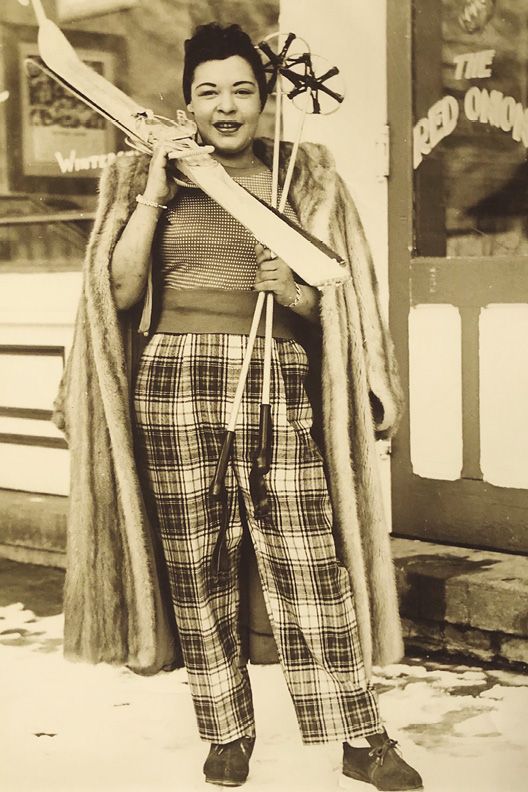
Aspen’s Red Onion in 1952.
Patrick Henry photo, courtesy
of the Henry Family.
Lady Day Hits the Slopes
In 1952, John Sihler, owner of the Red Onion Bar and Restaurant in Aspen, Colorado, hired Billie Holiday to sing at the Onion as part of the Wintersköl events in January. The town was already attracting Hollywood stars and famous musicians. In the 1950s, the Onion alone hosted greats Ella Fitzgerald, Duke Ellington, Oscar Peterson and Ray Brown. Holiday performed for six nights and put Aspen firmly on the live-music map.
“My mother was a waitress at the Red Onion when Billie sang there,” says artist and former longtime Aspen local Judy Haas. “There used to be a photo of her on the walls of the Red Onion, with Billie Holiday singing on stage!” At the peak of her fame, Holiday got to know some of the Onion’s employees who were aspiring performers, and after closing each night would sit and watch and give them tips while they sang. It wasn’t the usual behavior for a huge star and those who were there never forgot it.
It also wasn’t standard for visiting performers to learn to ski, but Holiday did that as well. This image shows her in a fur coat with a pair of what appear to be 10th Mountain Division signature white skis slung over one shoulder and 10th Mountain poles to match over the other. The photographer was the late Patrick Henry, who worked with the Berko studio in Aspen, and as far as anyone knows never provided many details on the shoot.
While this may have been a publicity photo for her Red Onion booking, she was seen by many people taking a lesson with a ski instructor on Aspen Mountain.
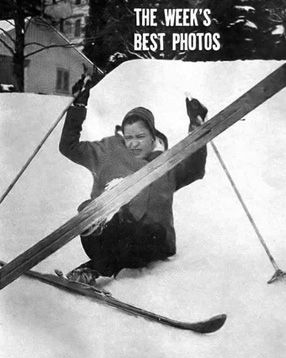
in Zurich in 1954, making the
UPI wire service.
During her 1954 European tour, UPI distributed a photo of Holiday getting up from a tumble on skis. The shot ran in Jet magazine, on February 25, 1954. The UPI caption read: “Billie Holiday Clobbers. While satisfying her newfound enthusiasm for skiing, singer Billie Holiday—now touring Europe—takes a spill in Zurich, Switzerland. Miss Holiday first tried skiing in Aspen, Colo.”
The Red Onion, built in 1892, at the height of Aspen’s silver boom, closed briefly in 2007. At that time it had been serving guests for 115 years, making it the oldest such business in Aspen. It reopened in 2009 but closed for Covid-19, and needs renovation before reopening.
Honoring the Red Onion’s legacy as a music venue, Jazz Aspen Snowmass (JAS) has purchased space above and adjacent to the Onion that will host the JAS offices, as well as rehearsal, lesson and performance spaces—and a gallery featuring some of its thousands of images of legendary artists. This photo is one of its prizes.— Jay Cowan
 Rites of Spring
Rites of Spring
At the end of April, about 1,800 enthusiasts celebrated the end of the Siberian winter by skiing Sheregesh resort in swimwear. It was the eighth annual Grelka Fest, named for a Russian hot-water bottle. Numbers didn’t quite reach the Guinness-certified world record of 1,835 set here in 2015, according to The Siberian Times. Originally billed as a bikini-skiing event, the rules were relaxed to allow one-piece swimwear for women and trunks for men. Swimwear skiing has been a rite of spring around the world at least since 1948 when Mt. Baker, Washington, staged its first Slush Cup pond-skimming contest. Inevitably, bikini slaloms followed, held at dozens of resorts on all continents. Many of these are charity
fundraisers. Some skiers go too far. For a quarter century, Crested Butte allowed nude skiing on the last day of the season, but after a few rowdies got drunk and disorderly, a dress code was enforced around 1996.
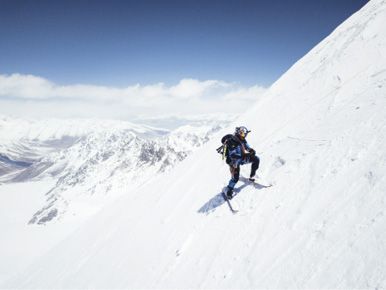
Two First Descents
On April 30, Polish mountaineer Andrzej Bargiel made the first ascent of 20,269-foot (6,178m) Yawash Sar II in the South Ghujerab Mountains in Karakorum, Pakistan. He immediately skied back to base camp and turned his attention to nearby 20,000-foot (6,096m) Laila Peak. With Jędrek Baranowski, he summitted on May 10. They then made the first ski descent, from just below the summit.
Bargiel, 33, is most famous for the 2018 first ski descent of K2, the second-highest peak in the world and considered by many as the most dangerous. He reported that his descent of Yawash Sar II was an altogether different experience. “The wall was very demanding, especially in the summit cone, but the descent was quite enjoyable,” Bargiel posted. “The descent itself took about 2 hours; It was icy at the summit, ropes were needed. Jędrek Baranowski, who also took part in the summit attack, waited for me halfway.”
Snapshots in Time
1955 A RELAXED NEED FOR SPEED
When the news came over the radio that Ralph Miller had just skied 109.04 miles per hour on August 26, SKI editors phoned him in Portillo, Chile, to get the story straight from the horse’s mouth. What did it feel like? “Pretty fast.” What were you wearing? “Oh, just goggles and a t-shirt.” —“SPEED RECORD” (SKI MAGAZINE, October 1955)
1981 TEACUP STEEPS
The headwall of Tuckerman Ravine on Mount Washington in New Hampshire is shaped like the inside of a teacup—and it is just about as steep, relatively speaking. On Memorial Day weekend, the most populous time for the headwall, skiers at various stages of paralysis, bravado and skill will be found adhering to the slope one way or another. —PETER MILLER, “SKIING THE STEEPS” (NEW YORK TIMES, JANUARY 25, 1981)
1996 YOU SAY YOU WANT A REVOLUTION
The Shaped Ski Revolution is here and it will make skiing more fun. It’s a revolution that will free thousands of skiers from the drudgery of the skidded turn, and thousands more will ski longer, stronger and faster. —JACKSON HOGEN, “REVOLUTION” (SNOW COUNTRY MAGAZINE, OCTOBER 1996)
2018 ONE MORE REASON TO KEEP SKIING
Skiing is a form of interval training, which has lately become one of the hottest fads in the fitness world. After pushing yourself for anywhere from 20 seconds to 15 minutes during a run, you get a nice break as you ride back up the hill. A growing body of evidence suggests this on-off style of training—working hard for a few minutes, then taking a breather—can provide a range of benefits, from extending your life to improving your fitness levels. —MARKHAM HEID, “WHY SKIING IS A RIDICULOUSLY GOOD WORKOUT” (TIME MAGAZINE, JANUARY 25, 2018)
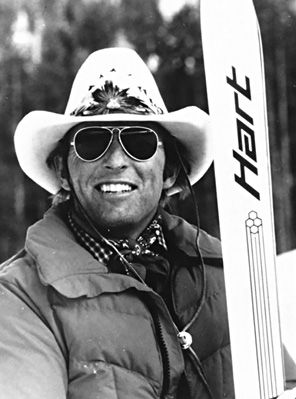 2021 50 YEARS A COWBOY William Winston Kidd celebrated his 50th anniversary as the indefatigable Director of Skiing at Colorado’s Steamboat Resort in April. At the 1964 Innsbruck Games, Kidd and teammate Jimmie Heuga were the first American men to win Olympic medals in alpine skiing, taking home slalom silver and bronze, respectively. Ever since, the always approachable Kidd, now 78, has helped bring skiing to the masses. He also influenced ski fashion—as only he could.
2021 50 YEARS A COWBOY William Winston Kidd celebrated his 50th anniversary as the indefatigable Director of Skiing at Colorado’s Steamboat Resort in April. At the 1964 Innsbruck Games, Kidd and teammate Jimmie Heuga were the first American men to win Olympic medals in alpine skiing, taking home slalom silver and bronze, respectively. Ever since, the always approachable Kidd, now 78, has helped bring skiing to the masses. He also influenced ski fashion—as only he could.

Table of Contents

Corporate Sponsors
ISHA deeply appreciates your generous support!
WORLD CHAMPIONSHIP ($3,000 AND UP)
Gorsuch
Polartec
CHAMPIONSHIP ($2,000)
Fairbank Group: Bromley, Cranmore, Jiminy Peak
Hickory & Tweed Ski Shop
WORLD CUP ($1,000)
Aspen Skiing Company
Bogner
Boyne Resorts
Dale of Norway
Darn Tough Vermont
Dynastar | Lange | Look
Gordini USA Inc. | Kombi LTD
HEAD Wintersports
Intuition Sports, Inc.
Mammoth Mountain
Marker-Volkl USA
National Ski Areas Association
Outdoor Retailer
Rossignol
Ski Area Management
Ski Country Sports
Snowsports Merchandising Corporation
Sport Obermeyer
Sports Specialists, Ltd.
Sun Valley Resort
Vintage Ski World
Warren and Laurie Miller
Yellowstone Club
GOLD ($700)
Larson's Ski & Sport
Race Place | BEAST Tuning Tools
The Ski Company (Rochester, NY)
Thule
SILVER ($500)
Alta Ski Area
Boden Architecture PLLC
Dalbello Sports
Deer Valley
Ecosign Mountain Resort Planners
Fera International
Holiday Valley
Hotronic USA, Inc. | Wintersteiger
MasterFit Enterprises
McWhorter Driscoll, LLC
Metropolitan New York Ski Council
Mt. Bachelor
New Jersey Ski & Snowboard Council
Russell Mace Vacation Homes
Schoeller Textile USA
Scott Sports
Seirus Innovations
SeniorsSkiing.com
Ski Utah
Steamboar Ski & Resort Corporation
Swiss Academic Ski Club
Tecnica Group USA
Timberline
Trapp Family Lodge
Western Winter Sports Reps Association
World Pro Ski Tour

